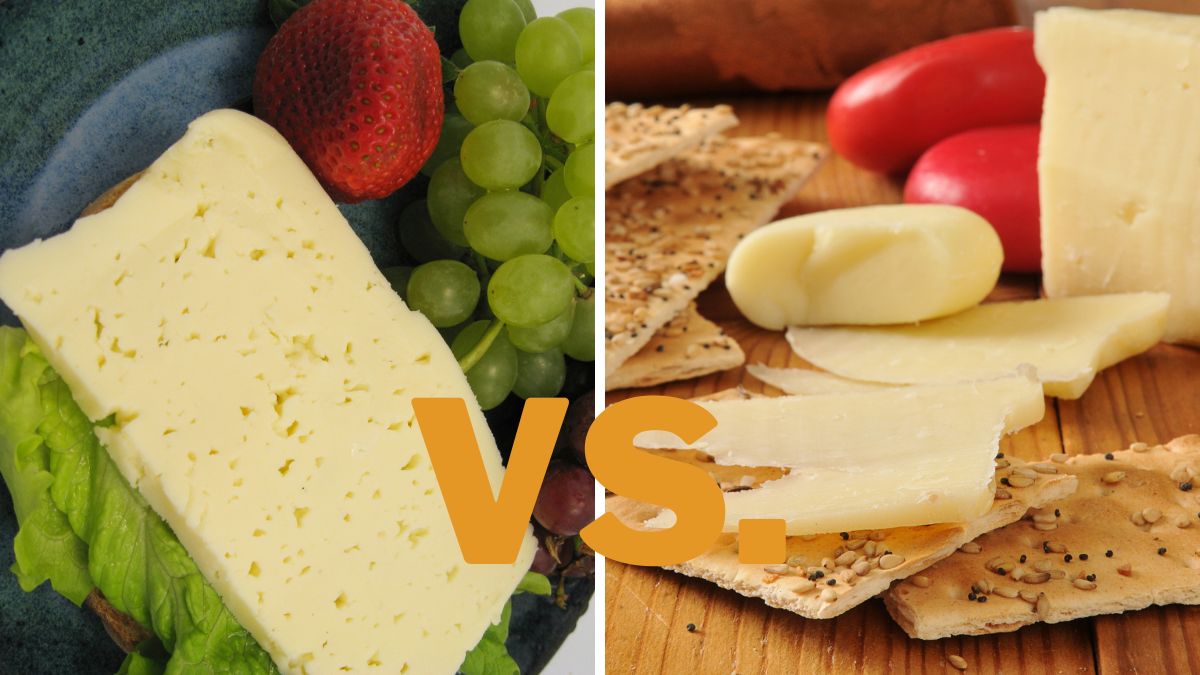Havarti vs. Gouda: Differences & Which Is Better?

Havarti and Gouda are two popular types of cheese that are great for snacking alone, with crackers or pieces of bread, but also melted into sandwiches or pizzas! You may have seen Gouda and Havarti cheese on your grocery store shelves, and you might have also used them both. However, do you know the differences between Havarti and Gouda, and more importantly, which one is better?
Havarti comes from Denmark, while Gouda comes from the Netherlands. Havarti has a soft texture and buttery taste, while Gouda has a semi-soft texture and mild taste. Also, Gouda contains less moisture, which means it has a longer shelf life when stored at room temperature, while Havarti has an added sweet note.
It’s no secret that both kinds of cheese are delicious. But while they have a lot in common, there’s no denying that these two kinds of cheese are also slightly different regarding texture, taste, nutrition, and uses. Read on to learn more about what sets them apart.
Havarti vs. Gouda: Differences
While, in most cases, you can easily substitute one for another, you should be aware that Havarti and Gouda behave differently from other ingredients. This also means they offer different characteristics in a dish. That’s why I am going to talk about them in detail.
Origins
Danish cheese Havarti gets its name from a farm in Denmark where it was first produced. Originally, Havarti was the name of a small island off the east coast of Denmark, further south than the town where this cheese originated.
One of the oldest cheeses in history, Gouda comes from the Netherlands and dates back to the 12th century. It got its name from the Dutch town of Gouda.
Preparation
Havarti is similar to Gouda in that it’s made from cow’s milk, but there are also some differences.
The production process of both cheeses is similar to that of many other cheeses. First, the milk is separated into curds and whey, and then the curds are pressed into round cheese wheels. They are then salted and stored for aging.
The step that distinguishes one cheese from another is washing the curds. In Gouda, the curd is rinsed with clean, warm water and then placed in a mold. The mold is then closed with a weight to squeeze out the excess liquid from the milk.
In Havarti, the milk ingredients are washed with salt water before being placed in the molds. When washing with warm water, the makers add salt to the bath to prevent lactic acid-producing bacteria from further processing the cheese.
Texture
While Gouda is a classic semi-soft cheese with a smooth, creamy texture usually made from cow’s milk (although it can also be made from sheep’s or goat’s milk), Havarti has a buttery and creamy texture and cuts like butter.
In addition, the texture of Gouda may also depend on how long you let it age. Compared to aged Gouda, which can be somewhat dry and a bit firmer due to moisture loss, young Gouda has a remarkably creamy texture.

Taste and Aging Process
Havarti and Gouda do have a similar buttery taste with added sweet notes, but Havarti is milder in flavor. Gouda, on the other hand, has a spicy undertone that Havarti cheese doesn’t have
Because of its creamy and buttery flavor, Havarti is one of the mildest and sweetest cheeses available, while Gouda’s flavor also depends on how long it’s been aged. Young Gouda is creamy, sweet, and mild, while older Gouda is stronger and spicier, reminiscent of caramel.
Most Gouda varieties are aged between one month and two years, while those made from sheep’s or goat’s milk can be aged up to seven years. On the other hand, Havarti doesn’t need to be aged for long. It only needs an hour or two to develop its characteristic flavor.
Melting Properties
Both Gouda and Havarti are fantastic melting cheeses that add the perfect touch to a variety of dishes. The wax that coats Gouda keeps moisture inside and prevents the cheese from drying out. If you then add a higher fat content, you get a cheese that melts perfectly.
Havarti cheese is in no way inferior to this. It’s also considered more pliable than Gouda, which makes it even better for melting.
Nutrition
As far as calories go, they’re both relatively low. Regarding fat, Havarti has a slightly higher number, while Gouda leads with protein numbers. Both cheeses are also rich in vitamins A and C, calcium, and a little bit of iron. [1] [2]
Uses
Creamy Gouda goes perfectly with all kinds of pasta. So if you’re a fan of mac and cheese, this is the cheese for you! Since it melts well, you can also use it for sandwiches, pizzas, mashed potatoes, or cheese soups.
Havarti can be used in the same way as Gouda. It can be melted, grilled, or simply sliced. Plus, these cheeses are very similar, so you can usually substitute them for each other. However, since Havarti is milder and softer, it’s best used in dishes that require a spreadable or melting cheese, as well as in sweet fruits and jams.
Havarti and young Gouda also go well on crackers and pieces of bread!
Havarti vs. Gouda: Which Is Better?
Everyone has their preferred type of cheese, but as we’ve seen, Havarti and Gouda are both similarly delicious cheeses made from semi-soft cow’s milk. However, there are some differences that speak to one or the other. So, if you’re looking for a cheese with a stronger flavor, Gouda is the better choice, while if you’re looking for a cheese with excellent melting properties, you should opt for Havarti.
Also, Gouda is a slightly better choice if you want to add extra protein to your diet. On the other hand, the milder Havarti is the right choice if you want to mix cheese and fruit flavors.
